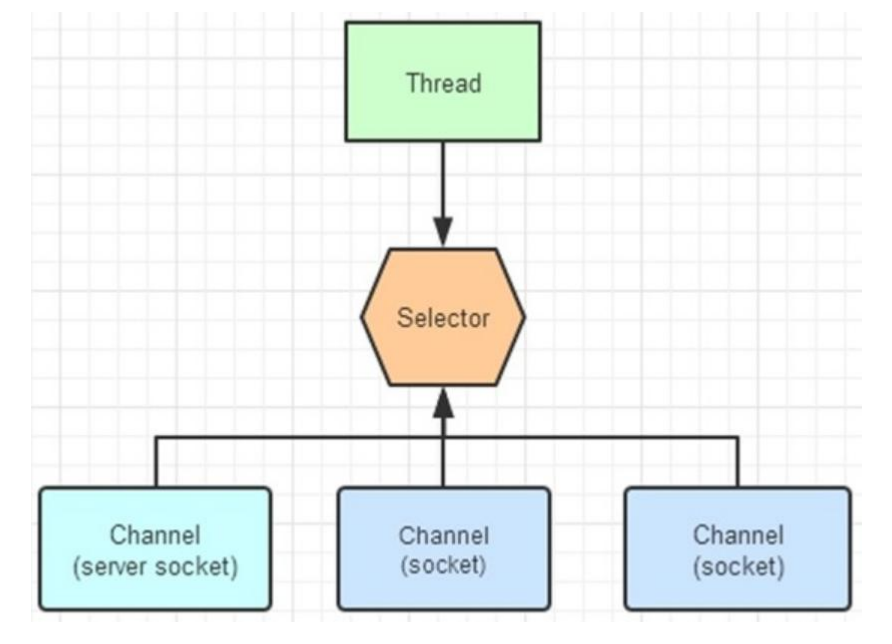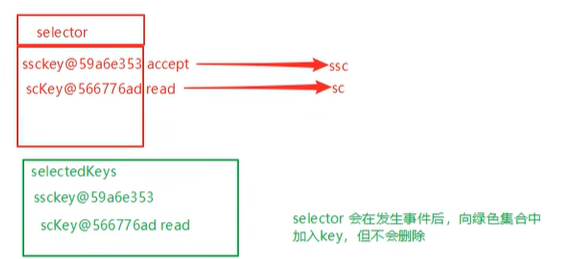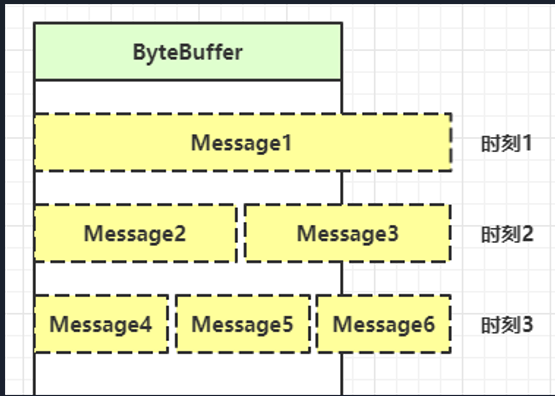NIO知识总结三
感兴趣的朋友可以去我的语雀平台进行查看更多的知识。
https://www.yuque.com/ambition-bcpii/muziteng
5. Selector
5.1 简介
5.1.1 Selector 和 Channel 关系
Selector 一般称为选择器 ,也可以翻译为多路复用器 。它是 Java NIO 核心组件中的一个,用于检查一个或多个 NIO Channel(通道)
的状态是否处于可读、可写。如此可以实现单线程管理多个 channels,也就是可以管理多个网络链接。

使用 Selector 的好处在于: 使用更少的线程来就可以来处理通道了, 相比使用多个线程,避免了线程上下文切换带来的开销。
5.1.2 可选择通道(SelectableChannel)
不是所有的 Channel 都可以被 Selector 复用的。比方说,FileChannel 就不能被选择器复用。判断一个 Channel 能被 Selector 复用,有
一个前提:判断他是否继承了一个抽象类 SelectableChannel。如果继承了 SelectableChannel,则可以被复用,否则不能。
一个通道可以被注册到多个选择器上,但对每个选择器而言只能被注册一次。通道和选择器之间的关系,使用注册的方式完成。
SelectableChannel 可以被注册到 Selector 对象上,在注册的时候,需要指定通道的哪些操作,是 Selector 感兴趣的。

5.1.3 Channel 注册到 Selector
使用 Channel.register(Selector sel,int ops方法,将一个通道注册到一个选择器时。第一个参数,指定通道要注册的选择器。
第二个参数指定选择器需要查询的通道操作。
可以供选择器查询的通道操作,从类型来分,包括以下四种:
- 可读 :
SelectionKey.OP_READ - 可写 :
SelectionKey.OP_WRITE - 连接 :
SelectionKey.OP_CONNECT - 接收 :
SelectionKey.OP_ACCEPT
如果 Selector 对通道的多操作类型感兴趣,可以用“位或”操作符来实现或者加减运算实现
选择器查询的不是通道的操作,而是通道的某个操作的一种就绪状态。什么是操作的就绪状态?一旦通道具备完成某个操作的条件,表示
该通道的某个操作已经就绪,就可以被 Selector 查询到,程序可以对通道进行对应的操作。比方说,某个 SocketChannel 通道可以连接
到一个服务器,则处于“连接就绪”(OP_CONNECT)。再比方说,一个 ServerSocketChannel 服务器通道准备好接收新进入的连接,则处于
“接收就绪”(OP_ACCEPT)状态。还比方说,一个有数据可读的通道,可以说是“读就绪”(OP_READ)。一个等待写数据的通道可以说是“写
就绪”(OP_WRITE)。
5.1.4 选择键(SelectionKey)
-
Channel 注册到后,并且一旦通道处于某种就绪的状态,就可以被选择器查询到。这个工作,使用选择器 Selector 的 select()方法
完成。select 方法的作用,对感兴趣的通道操作,进行就绪状态的查询。
-
Selector 可以不断的查询 Channel 中发生的操作的就绪状态。并且挑选感兴趣的操作就绪状态。一旦通道有操作的就绪状态达成,
并且是 Selector 感兴趣的操作,就会被 Selector 选中,放入选择键集合中。
-
一个选择键,首先是包含了注册在 Selector 的通道操作的类型,比方说SelectionKey.OP_READ。也包含了特定的通道与特定的选择
器之间的注册关系。
5.2 使用方法
5.2.1 创建与注册
// 1. 获取 selector
Selector selector = Selector.open();
// 2. 获取通道
ServerSocketChannel serverSocketChannel = ServerSocketChannel.open();
// 3. 设置非阻塞
serverSocketChannel.configureBlocking(false);
// 4. 绑定连接
serverSocketChannel.bind(new InetSocketAddress(9999));
// 5. 进行注册 将通道注册到选择器上,并制定监听事件为:“接收”事件
serverSocketChannel.register(selector, SelectionKey.OP_ACCEPT);
注意:与 Selector 一起使用时,Channel 必须处于非阻塞模式下,否则将抛出异常。
一个通道,并没有一定要支持所有的四种操作。比如服务器通道ServerSocketChannel 支持 Accept 接受操作,而 SocketChannel
客户端通道则不支持。可以通过通道上的 validOps() 方法,来获取特定通道下所有支持的操作集合。
5.2.2 轮询查询就绪操作
-
通过 Selector 的 select()方法,可以查询出已经就绪的通道操作,这些就绪的状态集合,包存在一个元素是 SelectionKey 对象的
Set 集合中
-
下面是 Selector 几个重载的查询 select()方法:
select():阻塞到至少有一个通道在你注册的事件上就绪了。select(long timeout):和 select()一样,但最长阻塞事件为 timeout 毫秒。selectNow():非阻塞,只要有通道就绪就立刻返回。
select()方法返回的 int 值,表示有多少通道已经就绪,更准确的说,是自前一次 select方法以来到这一次 select 方法之间的时间段
上,有多少通道变成就绪状态。
一旦调用 select()方法,并且返回值不为 0 时,在 Selector 中有一个 selectedKeys()方法,用来访问已选择键集合,迭代集合的每一个
选择键元素,根据就绪操作的类型,完成对应的操作。
事件发生后,要么处理,要么取消(cancel),不能什么都不做,否则下次该事件仍会触发
Iterator<SelectionKey> iter = selector.selectedKeys().iterator();
while (iter.hasNext()) {
SelectionKey key = iter.next();
if (key.isReadable()) {
// readable
} else if (key.isAcceptable()) {
// acceptable
} else if (key.isWritable()) {
// writable
} else if (key.isConnectable()) {
// connectable
}
iter.remove();
}
5.2.3 停止选择的办法
选择器执行选择的过程,系统底层会依次询问每个通道是否已经就绪,这个过程可能会造成调用线程进入阻塞状态,那么我们有以下三种方
式可以唤醒在 select()方法中阻塞的线程。
wakeup()方法 :通过调用 Selector 对象的 wakeup()方法让处在阻塞状态的 select()方法立刻返回
该方法使得选择器上的第一个还没有返回的选择操作立即返回。如果当前没有进行中的选择操作,那么下一次对 select()方法的一次调用
将立即返回
close()方法 :通过 close()方法关闭 Selector。
该方法使得任何一个在选择操作中阻塞的线程都被唤醒(类似 wakeup()),同时使得注册到该 Selector 的所有 Channel 被注销,所
有的键将被取消,但是 Channel本身并不会关闭。
5.3 NIO 编程步骤
- 创建 Selector 选择器
- 创建 ServerSocketChannel 通道,并绑定监听端口
- 设置 Channel 通道是非阻塞模式
- 把 Channel 注册到 Socketor 选择器上,监听连接事件
- 调用 Selector 的 select 方法(循环调用),监测通道的就绪状况
- 调用 selectKeys 方法获取就绪 channel 集合
- 遍历就绪 channel 集合,判断就绪事件类型,实现具体的业务操作
- 根据业务,决定是否需要再次注册监听事件,重复执行第三步操作
5.4 处理 accept 事件
客户端代码为
public class Client {
public static void main(String[] args) {
try (Socket socket = new Socket("localhost", 8080)) {
System.out.println(socket);
socket.getOutputStream().write("world".getBytes());
System.in.read();
} catch (IOException e) {
e.printStackTrace();
}
}
}
服务器端代码为
@Slf4j
public class ChannelDemo6 {
public static void main(String[] args) {
try (ServerSocketChannel channel = ServerSocketChannel.open()) {
channel.bind(new InetSocketAddress(8080));
Selector selector = Selector.open();
channel.configureBlocking(false);
channel.register(selector, SelectionKey.OP_ACCEPT);
while (true) {
int count = selector.select();
// int count = selector.selectNow();
log.debug("select count: {}", count);
// if(count <= 0) {
// continue;
// }
// 获取所有事件
Set<SelectionKey> keys = selector.selectedKeys();
// 遍历所有事件,逐一处理
Iterator<SelectionKey> iter = keys.iterator();
while (iter.hasNext()) {
SelectionKey key = iter.next();
// 判断事件类型
if (key.isAcceptable()) {
ServerSocketChannel c = (ServerSocketChannel) key.channel();
// 必须处理
SocketChannel sc = c.accept();
log.debug("{}", sc);
}
// 处理完毕,必须将事件移除
iter.remove();
}
}
} catch (IOException e) {
e.printStackTrace();
}
}
}
事件发生后,要么处理,要么取消(cancel),不能什么都不做,否则下次该事件仍会触发,这是因为 nio 底层使用的是水平触发
5.5 处理 read 事件
public static void main(String[] args) throws IOException {
// 1. 创建服务器
ServerSocketChannel ssc = ServerSocketChannel.open();
// 设置非阻塞模式
ssc.configureBlocking(false);
// 2. 创建 Selector 管理多个 channel
Selector selector = Selector.open();
// 3. 建立 selector 与 channel 的联系(注册)
// SelectionKey 就是将来事件发生后,通过它可以知道事件和哪了Channel的事件有联系
SelectionKey sscKey = ssc.register(selector, 0, null);
// key 只关注 accept 事件
sscKey.interestOps(SelectionKey.OP_ACCEPT);
log.debug("register key:{}", sscKey);
ssc.bind(new InetSocketAddress(8080));
while (true) {
// 4. select 方法 没有事件发生,线程阻塞,有事件发生,线程才恢复运行
// select 在事件未处理时,不会阻塞,事件发生后,要么处理,要么取消,不能置之不理
selector.select();
// 5. 处理事件 selectedKeys 内部包含了所有发生的事件
Iterator<SelectionKey> iter = selector.selectedKeys().iterator();
while (iter.hasNext()) {
SelectionKey key = iter.next();
iter.remove(); // 必须将事件进行移除
log.debug("key:{}", key);
// 6. 区分事件类型
if (key.isAcceptable()) {
ServerSocketChannel channel = (ServerSocketChannel) key.channel();
SocketChannel sc = channel.accept();
sc.configureBlocking(false);
SelectionKey scKey = sc.register(selector, 0, null);
scKey.interestOps(SelectionKey.OP_READ);
log.debug("{}", sc);
} else if (key.isReadable()) {
try {
SocketChannel channel = (SocketChannel) key.channel(); // 拿到触发事件的 channel
ByteBuffer byteBuffer = ByteBuffer.allocate(16);
int read = channel.read(byteBuffer); // 如果时正常断开 read 方法的返回值是-1
if (read == -1) {
key.cancel();
} else {
byteBuffer.flip();
debugRead(byteBuffer);
}
} catch (IOException e) {
e.printStackTrace();
key.cancel(); // 客户端断开了,因此需要将key取消(从selector 的 keys 集合中真正删除)
}
}
// key.cancel();
}
}
}
5.5.1 为何要 iter.remove()
因为 select 在事件发生后,就会将相关的 key 放入 selectedKeys 集合,但不会在处理完后从 selectedKeys 集合中移除,需要我们
自己编码删除。例如
- 第一次触发了 ssckey 上的 accept 事件,没有移除 ssckey
- 第二次触发了 sckey 上的 read 事件,但这时 selectedKeys 中还有上次的 ssckey ,在处理时因为没有真正的 serverSocket 连上了,就会导致空指针异常

5.5.2 cancel 的作用
cancel 会取消注册在 selector 上的 channel,并从 keys 集合中删除 key 后续不会再监听事件
5.5.3 ⚠️ 不处理边界的问题
以前有同学写过这样的代码,思考注释中两个问题,以 bio 为例,其实 nio 道理是一样的
public class Server {
public static void main(String[] args) throws IOException {
ServerSocket ss=new ServerSocket(9000);
while (true) {
Socket s = ss.accept();
InputStream in = s.getInputStream();
// 这里这么写,有没有问题
byte[] arr = new byte[4];
while(true) {
int read = in.read(arr);
// 这里这么写,有没有问题
if(read == -1) {
break;
}
System.out.println(new String(arr, 0, read));
}
}
}
}
客户端
public class Client {
public static void main(String[] args) throws IOException {
Socket max = new Socket("localhost", 9000);
OutputStream out = max.getOutputStream();
out.write("hello".getBytes());
out.write("world".getBytes());
out.write("你好".getBytes());
max.close();
}
}
输出
hell
owor
ld�
�好
5.5.4 处理消息的边界
会出现半包、粘包问题

- 一种思路是固定消息长度,数据包大小一样,服务器按预定长度读取,缺点是浪费带宽
- 另一种思路是按分隔符拆分,缺点是效率低
- TLV 格式,即 Type 类型、Length 长度、Value 数据,类型和长度已知的情况下,就可以方便获取消息大小,分配合适的 buffer,缺点是 buffer 需要提前分配,如果内容过大,则影响 server 吞吐量
- Http 1.1 是 TLV 格式
- Http 2.0 是 LTV 格式
服务器端
private static void split(ByteBuffer source) {
source.flip();
for (int i = 0; i < source.limit(); i++) {
// 找到一条完整消息
if (source.get(i) == '\n') {
int length = i + 1 - source.position();
// 把这条完整消息存入新的 ByteBuffer
ByteBuffer target = ByteBuffer.allocate(length);
// 从 source 读,向 target 写
for (int j = 0; j < length; j++) {
target.put(source.get());
}
debugAll(target);
}
}
source.compact(); // 0123456789abcdef position 16 limit 16
}
public static void main(String[] args) throws IOException {
// 1. 创建 selector, 管理多个 channel
Selector selector = Selector.open();
ServerSocketChannel ssc = ServerSocketChannel.open();
ssc.configureBlocking(false);
// 2. 建立 selector 和 channel 的联系(注册)
// SelectionKey 就是将来事件发生后,通过它可以知道事件和哪个channel的事件
SelectionKey sscKey = ssc.register(selector, 0, null);
// key 只关注 accept 事件
sscKey.interestOps(SelectionKey.OP_ACCEPT);
log.debug("sscKey:{}", sscKey);
ssc.bind(new InetSocketAddress(8080));
while (true) {
// 3. select 方法, 没有事件发生,线程阻塞,有事件,线程才会恢复运行
// select 在事件未处理时,它不会阻塞, 事件发生后要么处理,要么取消,不能置之不理
selector.select();
// 4. 处理事件, selectedKeys 内部包含了所有发生的事件
Iterator<SelectionKey> iter = selector.selectedKeys().iterator(); // accept, read
while (iter.hasNext()) {
SelectionKey key = iter.next();
// 处理key 时,要从 selectedKeys 集合中删除,否则下次处理就会有问题
iter.remove();
log.debug("key: {}", key);
// 5. 区分事件类型
if (key.isAcceptable()) { // 如果是 accept
ServerSocketChannel channel = (ServerSocketChannel) key.channel();
SocketChannel sc = channel.accept();
sc.configureBlocking(false);
ByteBuffer buffer = ByteBuffer.allocate(16); // attachment
// 将一个 byteBuffer 作为附件关联到 selectionKey 上
SelectionKey scKey = sc.register(selector, 0, buffer);
scKey.interestOps(SelectionKey.OP_READ);
log.debug("{}", sc);
log.debug("scKey:{}", scKey);
} else if (key.isReadable()) { // 如果是 read
try {
SocketChannel channel = (SocketChannel) key.channel(); // 拿到触发事件的channel
// 获取 selectionKey 上关联的附件
ByteBuffer buffer = (ByteBuffer) key.attachment();
int read = channel.read(buffer); // 如果是正常断开,read 的方法的返回值是 -1
if(read == -1) {
key.cancel();
} else {
split(buffer);
// 需要扩容
if (buffer.position() == buffer.limit()) {
ByteBuffer newBuffer = ByteBuffer.allocate(buffer.capacity() * 2);
buffer.flip();
newBuffer.put(buffer); // 0123456789abcdef3333\n
key.attach(newBuffer);
}
}
} catch (IOException e) {
e.printStackTrace();
key.cancel(); // 因为客户端断开了,因此需要将 key 取消(从 selector 的 keys 集合中真正删除 key)
}
}
}
}
}
客户端
SocketChannel sc = SocketChannel.open();
sc.connect(new InetSocketAddress("localhost", 8080));
SocketAddress address = sc.getLocalAddress();
// sc.write(Charset.defaultCharset().encode("hello\nworld\n"));
sc.write(Charset.defaultCharset().encode("0123\n456789abcdef"));
sc.write(Charset.defaultCharset().encode("0123456789abcdef3333\n"));
System.in.read();
5.5.5 ByteBuffer 大小分配
- 每个 channel 都需要记录可能被切分的消息,因为 ByteBuffer 不能被多个 channel 共同使用,因此需要为每个 channel 维护一个独立的 ByteBuffer
- ByteBuffer 不能太大,比如一个 ByteBuffer 1Mb 的话,要支持百万连接就要 1Tb 内存,因此需要设计大小可变的 ByteBuffer
- 一种思路是首先分配一个较小的 buffer,例如 4k,如果发现数据不够,再分配 8k 的 buffer,将 4k buffer 内容拷贝至 8k buffer,优点是消息连续容易处理,缺点是数据拷贝耗费性能,参考实现 http://tutorials.jenkov.com/java-performance/resizable-array.html
- 另一种思路是用多个数组组成 buffer,一个数组不够,把多出来的内容写入新的数组,与前面的区别是消息存储不连续解析复杂,优点是避免了拷贝引起的性能损耗
5.6 处理 write 事件
5.6.1 一次无法写完例子
- 非阻塞模式下,无法保证把 buffer 中所有数据都写入 channel,因此需要追踪 write 方法的返回值(代表实际写入字节数)
- 用 selector 监听所有 channel 的可写事件,每个 channel 都需要一个 key 来跟踪 buffer,但这样又会导致占用内存过多,就有两阶段策略
- 当消息处理器第一次写入消息时,才将 channel 注册到 selector 上
- selector 检查 channel 上的可写事件,如果所有的数据写完了,就取消 channel 的注册
- 如果不取消,会每次可写均会触发 write 事件
public class WriteServer {
public static void main(String[] args) throws IOException {
ServerSocketChannel ssc = ServerSocketChannel.open();
ssc.configureBlocking(false);
ssc.bind(new InetSocketAddress(8080));
Selector selector = Selector.open();
ssc.register(selector, SelectionKey.OP_ACCEPT);
while(true) {
selector.select();
Iterator<SelectionKey> iter = selector.selectedKeys().iterator();
while (iter.hasNext()) {
SelectionKey key = iter.next();
iter.remove();
if (key.isAcceptable()) {
SocketChannel sc = ssc.accept();
sc.configureBlocking(false);
SelectionKey sckey = sc.register(selector, SelectionKey.OP_READ);
// 1. 向客户端发送内容
StringBuilder sb = new StringBuilder();
for (int i = 0; i < 3000000; i++) {
sb.append("a");
}
ByteBuffer buffer = Charset.defaultCharset().encode(sb.toString());
int write = sc.write(buffer);
// 3. write 表示实际写了多少字节
System.out.println("实际写入字节:" + write);
// 4. 如果有剩余未读字节,才需要关注写事件
if (buffer.hasRemaining()) {
// read 1 write 4
// 在原有关注事件的基础上,多关注 写事件
sckey.interestOps(sckey.interestOps() + SelectionKey.OP_WRITE);
// 把 buffer 作为附件加入 sckey
sckey.attach(buffer);
}
} else if (key.isWritable()) {
ByteBuffer buffer = (ByteBuffer) key.attachment();
SocketChannel sc = (SocketChannel) key.channel();
int write = sc.write(buffer);
System.out.println("实际写入字节:" + write);
if (!buffer.hasRemaining()) { // 写完了
key.interestOps(key.interestOps() - SelectionKey.OP_WRITE);
key.attach(null);
}
}
}
}
}
}
客户端
public class WriteClient {
public static void main(String[] args) throws IOException {
Selector selector = Selector.open();
SocketChannel sc = SocketChannel.open();
sc.configureBlocking(false);
sc.register(selector, SelectionKey.OP_CONNECT | SelectionKey.OP_READ);
sc.connect(new InetSocketAddress("localhost", 8080));
int count = 0;
while (true) {
selector.select();
Iterator<SelectionKey> iter = selector.selectedKeys().iterator();
while (iter.hasNext()) {
SelectionKey key = iter.next();
iter.remove();
if (key.isConnectable()) {
System.out.println(sc.finishConnect());
} else if (key.isReadable()) {
ByteBuffer buffer = ByteBuffer.allocate(1024 * 1024);
count += sc.read(buffer);
buffer.clear();
System.out.println(count);
}
}
}
}
}
5.6.2 write 为何要取消
只要向 channel 发送数据时,socket 缓冲可写,这个事件会频繁触发,因此应当只在 socket 缓冲区写不下时再关注可写事件,数据写完
之后再取消关注
5.7 示例代码
5.7.1 服务器端代码
public static void main(String[] args) {
try {
ServerSocketChannel ssc = ServerSocketChannel.open();
ssc.bind(new InetSocketAddress(8000));
ssc.configureBlocking(false);
Selector selector = Selector.open();
ssc.register(selector, SelectionKey.OP_ACCEPT);
ByteBuffer readBuffer = ByteBuffer.allocate(1024);
ByteBuffer writeBuffer = ByteBuffer.allocate(128);
writeBuffer.put("received".getBytes(StandardCharsets.UTF_8));
writeBuffer.flip();
while (selector.select() > 0) {
Iterator<SelectionKey> iter = selector.selectedKeys().iterator();
while (iter.hasNext()) {
// 获取就绪操作
SelectionKey key = iter.next();
iter.remove();
if (key.isAcceptable()) {
// 创建新的连接,并且把连接注册到 selector 上,而且
// 声明这个 channel 只对读操作感兴趣。
SocketChannel sc = ssc.accept();
sc.configureBlocking(false);
sc.register(selector, SelectionKey.OP_READ);
} else if (key.isReadable()) {
SocketChannel sc = (SocketChannel) key.channel();
// 读取数据
int length = 0;
while ((length = sc.read(readBuffer)) > 0) {
readBuffer.flip();
System.out.println("received:" + new String(readBuffer.array(), 0, length));
readBuffer.clear();
}
key.interestOps(SelectionKey.OP_WRITE);
} else if (key.isWritable()) {
writeBuffer.rewind();
SocketChannel sc = (SocketChannel) key.channel();
sc.write(writeBuffer);
key.interestOps(SelectionKey.OP_READ);
}
}
}
} catch (IOException e) {
throw new RuntimeException(e);
}
}
5.7.2 客户端代码
public static void main(String[] args) {
try {
SocketChannel sc = SocketChannel.open();
sc.connect(new InetSocketAddress("localhost", 8000));
ByteBuffer writeBuffer = ByteBuffer.allocate(32);
ByteBuffer readBuffer = ByteBuffer.allocate(32);
writeBuffer.put("hello".getBytes(StandardCharsets.UTF_8));
writeBuffer.flip();
while (true) {
writeBuffer.rewind();
sc.write(writeBuffer);
readBuffer.clear();
sc.read(readBuffer);
}
} catch (IOException e) {
throw new RuntimeException(e);
}
}
